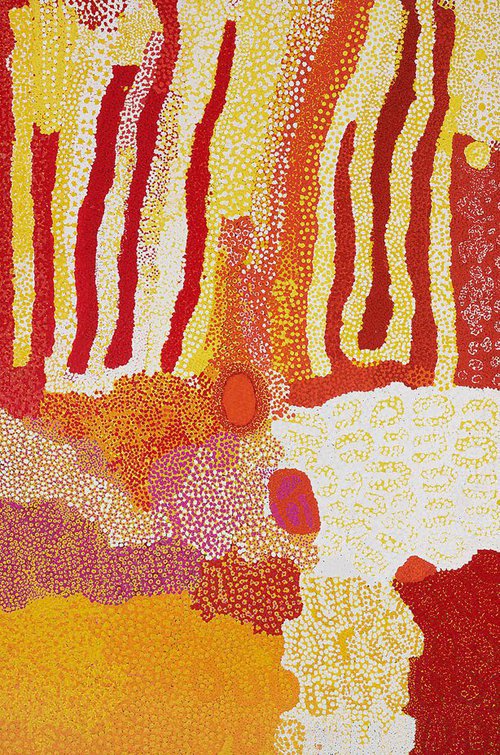Title
Winpurpurla
2002
Artist
Lucy Yukenbarri Napanangka
Australia
1934 – Apr 2003
Language group: Wangkajunga, Western Desert region
-
Details
- Place where the work was made
-
Balgo Hills
→
East Kimberley
→
Western Australia
→
Australia
- Date
- 2002
- Media category
- Materials used
- four-colour screenprint, red, yellow, pink and white inks on white wove paper
- Edition
- 9/50
- Dimensions
- 64.5 x 49.0 cm image (irreg.); 75.8 x 55.7 cm sheet
- Signature & date
Signed l.r. corner, pencil "X". Not dated.
- Credit
- Mollie Gowing Acquisition fund for Contemporary Aboriginal art 2003
- Location
- Not on display
- Accession number
- 416.2003
- Copyright
- © Estate of Lucy Yukenbarri Napanangka/Copyright Agency
- Artist information
-
Lucy Yukenbarri Napanangka
Works in the collection
- Share
-
-
About
Lucy Yukenbarri Napanangka, who passed away in April 2003, is best known as a painter working for Warlayirti Artists at Wirrimanu (Balgo). In recent years she produced prints in association with Northern Editions print workshop at the Northern Territory University. In this print the strikingly captivating Balgo colour-fields are translated into the print medium.
Documentation from Warlayirti Artists states that this work depicts Lucy Yukenbarri Napanangka's grandmother's country. This country is located far to the south of Balgo in the Great Sandy Desert. This screenprint features some of the country around a tjurrnu or soakwater called Winpurpurla. Winpurpurla is an inta, or 'living water' place as it always has good water. The Tjukurrpa (Dreaming) story for this country tells of some ancestral women of the Nungarrayi, nampitjin and napangardi skin groups who came to camp at Winpurpurla. These ancestral women made a fire close to the water and started dancing a secret/sacred dance. The dancing went on all night after which they started walking a long way west. The woman came to Winpurpurla to collect some of the special food that grows there, in particular the murlanpa, a flower harvested from the 'sugar tree', which is eaten raw and is a great delicacy.
This print exemplifies the expressive Balgo style and daring use of colour that has earned this remote art community an international reputation. Although the Balgo community was some ten years behind the Papunya artists in starting up their art centre, they have quickly established themselves as a formidable presence in Australian art. While their works relate to their fellow Western Desert artists in Kintore and Kiwirrkura, Balgo artists paint with less restraint, demonstrating an immediacy and spontaneity. The preferred palette of rich reds, oranges and yellows evokes the dramatic landscape around Balgo.
Prints from Balgo are part of the move into new media for this community. The paintings style of Balgo artists translates very successfully to this medium, allowing as it does for the simulation of great depth and intense colour. Furthermore, these works captures the essence of each artist's characteristic style.
Printmaking is an increasing area of art practice for remote area communities and is particularly accessible to older, more senior artists. They allow a greater freedom of expression for less mobile artists and are less strenuous. As a result, these prints often carry the traditional authority of a community and their creation plays a valuable role in passing on cultural information to younger generations of artists.
© Australian Art Department, Art Gallery of New South Wales, 2003
-
Places
Where the work was made
Balgo Hills
-
Exhibition history
Shown in 2 exhibitions
Balgo prints: a recent survey, Northern Territory University Art Gallery, Darwin, 16 Aug 2003–29 Aug 2003
Wirrimanu: art from Balgo, Art Gallery of New South Wales, Sydney, 27 Jul 2019–17 Nov 2019
-
Bibliography
Referenced in 1 publication
-
Alison Harper, Art and Australia (Vol. 41, No. 4), 'Aboriginal art: aquisitions by Australia's public museums and galleries', pg. 612-614, Sydney, Jun 2004-Aug 2004, 613.
-



